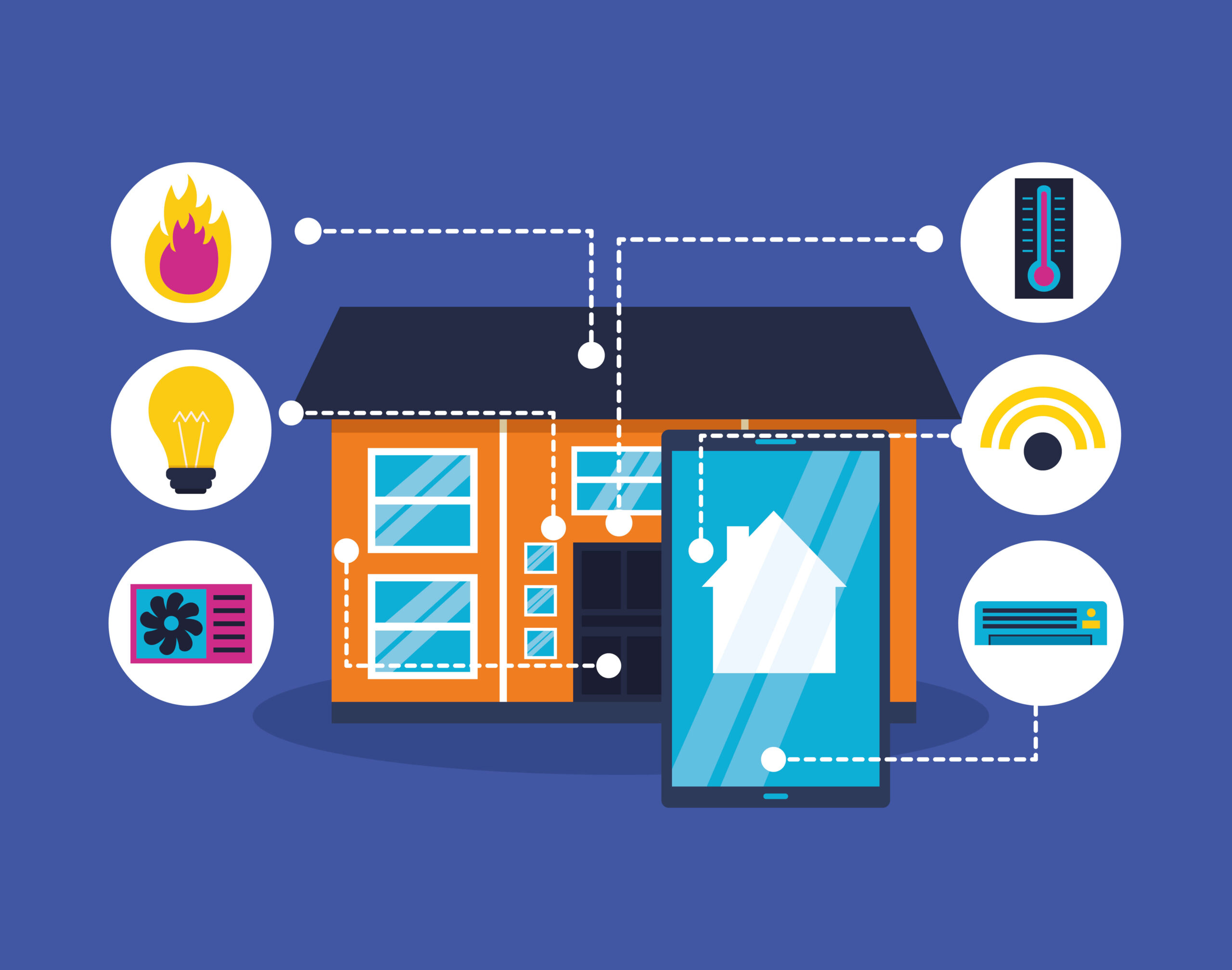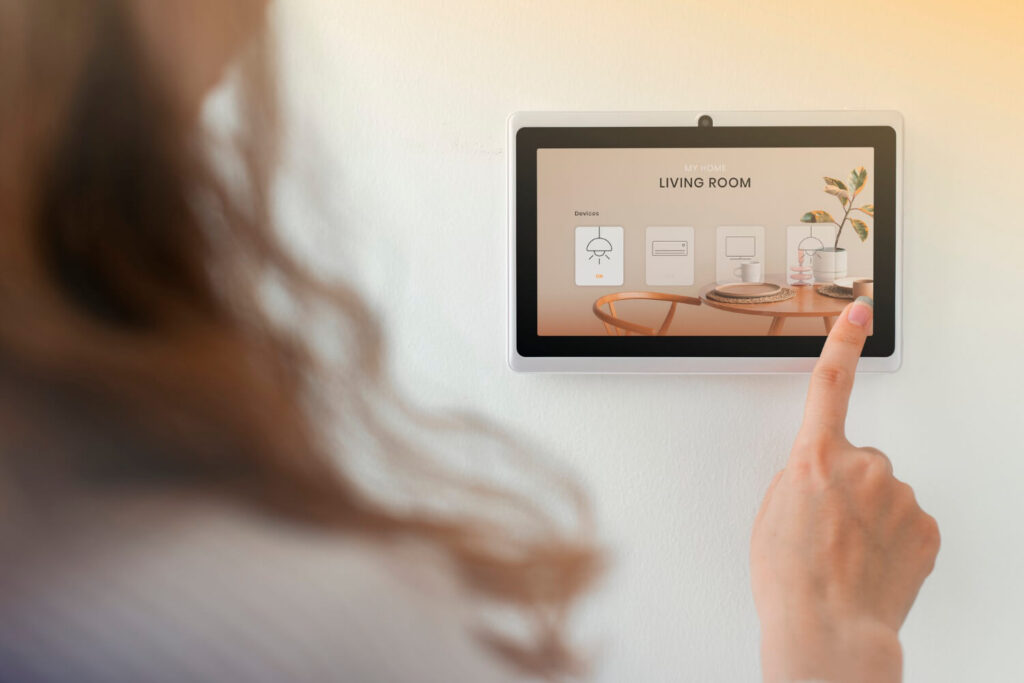Smart Home Control: The Ultimate Guide to Automating Your Home
Are you tired of manually adjusting your thermostat, turning off lights, and locking doors? Smart home control may be the solution for you. With smart home technology, you can automate and control various aspects of your home using your smartphone or voice commands.
 Smart home control systems allow you to connect and control all of your smart devices in one place. You can adjust your thermostat, turn off lights, lock doors, and even monitor your home security system all from one app. Additionally, smart home systems can learn your habits and preferences, adjusting settings automatically to optimize energy usage and save you money on your utility bills.
Smart home control systems allow you to connect and control all of your smart devices in one place. You can adjust your thermostat, turn off lights, lock doors, and even monitor your home security system all from one app. Additionally, smart home systems can learn your habits and preferences, adjusting settings automatically to optimize energy usage and save you money on your utility bills.
Not only does smart home control provide convenience and energy savings, but it can also increase the security of your home. With the ability to remotely monitor and control your home security system, you can have peace of mind knowing that your home is protected even when you’re away. As technology continues to advance, smart home control is becoming more accessible and affordable, making it a viable option for homeowners looking to simplify their lives and increase the efficiency and security of their homes.
Understanding Smart Home Control
Definition of Smart Home Control
Smart home control refers to the ability to manage and control various devices and appliances in your home through a central system. This system can be accessed through a smartphone, tablet, or other smart device. Smart home control systems typically include a hub or controller that connects to the internet and communicates with other devices in your home.
Smart home control allows you to automate and customize your home’s various systems and appliances, such as lighting, heating and cooling, security systems, and entertainment systems. With smart home control, you can set up schedules, create routines, and control your devices remotely, giving you greater convenience and control over your home.
One of the most significant benefits of smart home control is the ability to save energy and reduce your utility bills. For example, you can set your thermostat to automatically adjust the temperature when you’re away from home, or turn off lights and appliances when they’re not in use.
Smart home control systems can also provide added security and peace of mind. You can monitor your home’s security cameras and lock or unlock doors remotely, or receive alerts when someone enters or leaves your home.
Overall, smart home control is a powerful tool that can make your home more convenient, efficient, and secure. With the right system and setup, you can customize your home to meet your specific needs and preferences, and enjoy greater control over your environment.
Components of Smart Home Control

Smart Home Hub
All of your smart home devices are connected to and managed by a single device called a hub. With the use of a single app or voice command, it serves as a bridge between your Wi-Fi network and your smart devices, enabling you to manage them.
There are many different types of smart home hubs available, each with its own set of features and compatibility. Some popular options include the Amazon Echo, Google Home, and Samsung SmartThings.
When choosing a smart home hub, consider the types of devices you already have or plan to add to your home. Make sure the hub is compatible with those devices and that it has the features you need, such as voice control or the ability to create custom scenes.
Smart Devices
The parts that make up your smart home system are called smart gadgets. They can range from thermostats and smart lighting to door locks and security cameras.
When choosing smart devices, look for ones that are compatible with your chosen smart home hub and that meet your specific needs. For example, if you want to control your home’s temperature remotely, a smart thermostat like the Nest or Ecobee might be a good choice.
It’s also important to consider the quality and reliability of the devices you choose. Look for devices with good reviews and a proven track record of performance.
Overall, building a smart home system requires careful consideration of both the smart home hub and the individual smart devices you choose. By selecting the right components, you can create a convenient and efficient smart home that meets your needs and enhances your daily life.
Benefits of Smart Home Control
Smart home control is becoming increasingly popular due to the numerous benefits it offers. Here are some of the key benefits of using smart home control to manage your home:
Energy Efficiency
One of the most significant benefits of smart home control is improved energy efficiency. Smart home systems allow you to monitor and control your energy usage more effectively, which can help you save money on your energy bills. For example, you can use smart thermostats to adjust the temperature in your home based on your schedule and preferences, which can help reduce energy waste. Additionally, smart lighting systems can automatically turn off lights when you leave a room, reducing unnecessary energy consumption.
Convenience
Smart home control systems offer a high level of convenience, allowing you to manage your home from anywhere using your smartphone or tablet. With smart home control, you can easily turn lights on and off, adjust the temperature, and even lock and unlock doors remotely. This can be especially useful if you’re away from home and want to make sure everything is secure.
Security
Smart home control systems can also improve the security of your home. With smart locks, you can lock and unlock your doors remotely, allowing you to let in guests or service providers without having to be there in person. Additionally, smart home security systems can alert you if there’s any unusual activity in or around your home, helping you stay informed and take action if necessary.
Overall, smart home control offers a range of benefits that can improve your quality of life and help you save money. By using smart home systems to manage your energy usage, increase convenience, and enhance security, you can enjoy a more comfortable and efficient home environment.
Smart Home Control Systems
Smart home control systems allow you to control various devices in your home using your smartphone or voice commands. These systems can help you automate your home and make your life more convenient. In this section, we’ll cover some popular smart home systems and how to choose the right one for you.
Popular Smart Home Systems
There are many different smart home systems on the market, and each one has different features and functionalities. Some of the most well-liked systems are listed below:
- Amazon Alexa: There are many different smart home systems on the market, and each one has different features and functionalities. Some of the most well-liked systems are listed below:
- Google Home: Google Home is a smart speaker that can control various smart home devices using voice commands. You can use Google Home to play music, set alarms, and control your smart home devices.
- Apple HomeKit: HomeKit is a smart home platform developed by Apple that allows you to control various smart home devices using your iPhone, iPad, or Apple Watch. You can use HomeKit to control your lights, thermostat, and even your garage door.
Choosing a Smart Home System
When choosing a smart home system, there are a few things to consider:
- Compatibility: Make sure the smart home system you choose is compatible with the devices you already have in your home.
- Ease of Use: Look for a system that is easy to set up and use, and that has an intuitive interface.
- Features: Consider the features you need, such as voice control, automation, and security.
- Cost: Smart home systems can vary in price, so consider your budget when choosing a system.
Overall, smart home control systems can make your life more convenient and help you automate your home. Consider your needs and budget when choosing a system that’s right for you.
Related Posts:
Installation and Setup
Setting up a smart home control system can seem daunting, but with the right approach, it can be a straightforward process. Here are some steps to follow to ensure a smooth installation and setup process:
- Determine your needs: Before you start shopping for smart home control systems, take some time to determine what your needs are. Consider what devices you want to control, what features you need, and what your budget is.
- Choose a system: It’s time to select a smart home control system after you are aware of what you require. Do your study to identify the choice that best suits your needs because there are many options accessible.
- Install the hardware: Once you have your smart home control system, it’s time to install the hardware. This may involve connecting devices such as smart lights, thermostats, and security cameras to your network.
- Download the app: Most smart home control systems come with a companion app that you can download to your smartphone or tablet. This app will allow you to control your devices and customize your settings.
- Set up your devices: Once you have the app installed, it’s time to set up your devices. This may involve creating user profiles, setting schedules, and customizing settings.
- Test your system: After you have everything set up, it’s important to test your system to make sure everything is working properly. Test each device and feature to ensure that everything is functioning as expected.
By following these steps, you can set up a smart home control system that meets your needs and makes your life easier.
Troubleshooting and Maintenance
Smart home systems are designed to make your life easier, but they are not immune to problems. When something goes wrong, it can be frustrating, but don’t worry, most issues can be resolved with a little troubleshooting. Here are some common problems you might encounter and how to fix them:
Connectivity Issues
If your smart home device is not connecting to your network, the first thing to check is your Wi-Fi signal. Make sure your router is turned on and that you are within range. If your signal is weak, consider moving your router or installing a Wi-Fi extender. If your device still won’t connect, try restarting it or resetting it to its factory settings.
Device Compatibility
Before purchasing a smart home device, make sure it is compatible with your existing system. Some devices may only work with certain hubs or platforms. If you are unsure, check the manufacturer’s website for compatibility information.
Software Updates
Just like your computer or phone, smart home devices require software updates to fix bugs and improve performance. Make sure you are running the latest version of your device’s software by checking for updates regularly.
Maintenance
To keep your smart home system running smoothly, it’s important to perform regular maintenance. This includes cleaning your devices, checking for loose wires or connections, and replacing batteries as needed.
Troubleshooting Tips
Here are some additional tips for troubleshooting common smart home problems:
- Check the power source: Make sure your device is plugged in or has fresh batteries.
- Restart the device: Sometimes a simple restart can fix connectivity issues.
- Check the app: Make sure you are using the correct app and that it is up to date.
- Contact customer support: If you are still having issues, contact the manufacturer’s customer support for assistance.
By following these troubleshooting and maintenance tips, you can keep your smart home system running smoothly and enjoy the convenience and comfort it provides.
Future of Smart Home Control
As technology continues to evolve, so does the future of smart home control. The advancements in artificial intelligence, voice recognition, and machine learning have already made a significant impact on how we interact with our homes. In the future, smart home control systems will become even more intelligent and intuitive, making it easier for you to manage your home.
One of the most significant changes in the future of smart home control is the integration of smart devices. Smart home control systems will seamlessly connect all of your smart devices, allowing you to control them from a single interface. This will make it easier for you to manage your home, as you won’t have to switch between different apps or devices to control your home.
In addition, smart home control systems will become more personalized. They will learn your preferences and habits, and adjust your home’s settings accordingly. For example, your smart home control system might automatically adjust the temperature and lighting in your home based on your schedule, or turn on your favorite music when you walk in the door.
Another major change in the future of smart home control is the integration of augmented and virtual reality. Smart home control systems will allow you to visualize your home in augmented or virtual reality, giving you a more immersive experience. This will help you to better understand your home’s layout and make it easier to control your home.
Overall, the future of smart home control is exciting. With the integration of smart devices, personalization, and augmented and virtual reality, smart home control systems will become even more intuitive and intelligent.
FAQs
- What is Smart Home Control, and how does it work?
- Answer: Smart Home Control refers to the ability to manage and automate various devices and systems in your home, such as lighting, thermostats, security cameras, and appliances, using technology like smartphones or voice commands. It works through interconnected devices, sensors, and a central hub to provide convenience and efficiency in managing your home.
- What are the benefits of implementing Smart Home Control?
- Answer: Implementing Smart Home Control offers numerous benefits, including increased energy efficiency, enhanced security, convenience, and the ability to customize your home environment to suit your preferences. It can also save you time and money by automating routine tasks.
- What are the common devices and systems that can be controlled in a smart home?
- Answer: Smart Home Control can be used to manage a wide range of devices and systems, including lighting, thermostats, locks, security cameras, doorbells, audio and entertainment systems, and even kitchen appliances. It’s a versatile technology that can be tailored to your specific needs.
- What are the different methods of controlling a smart home?
- Answer: Smart homes can be controlled through various methods, such as mobile apps on smartphones or tablets, voice assistants like Amazon Alexa or Google Assistant, remote control devices, and web interfaces. Some systems also offer automated scheduling and sensor-based control.
- Is Smart Home Control safe and secure?
- Answer: Smart Home Control systems are designed with security in mind, but it’s essential to take steps to protect your network and devices. Use strong passwords, enable two-factor authentication, and keep your devices and software up to date to minimize security risks. Additionally, choose reputable brands and ensure that your network is secure to maintain the safety of your smart home system.
Most Related Post : GOOGLE HOME SMART PLUG: A SMARTER WAY TO CONTROL YOUR DEVICES



